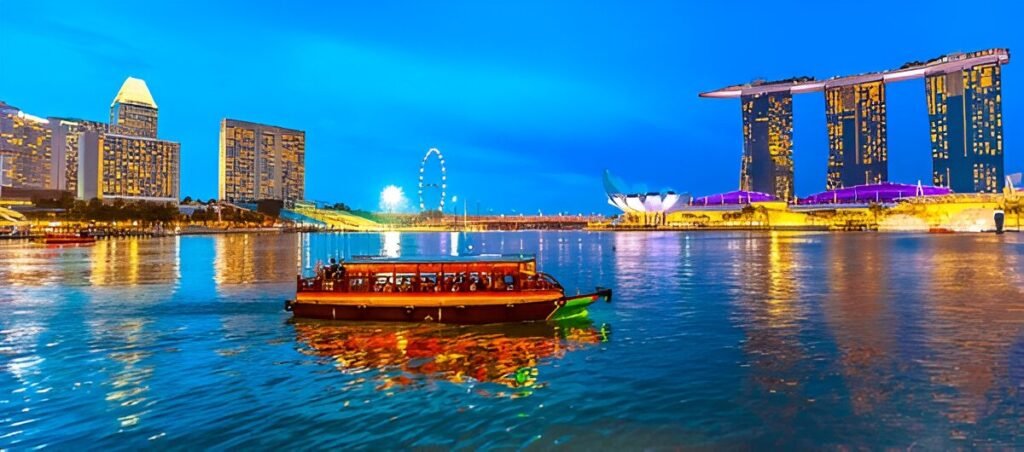Introduction
The Singapore River has long been an integral part of the city-state’s history, culture, and economy. Flowing through the heart of Singapore, this river was once the main artery of trade and commerce, serving as a crucial waterway for merchants and settlers. Today, the river has transformed into a scenic destination, offering a mix of historical landmarks, modern entertainment hubs, and picturesque views. This comprehensive guide explores the rich history of the Singapore River, its significant landmarks, and the vibrant attractions that make it a must-visit spot.
The Historical Significance of the Singapore River

The Early Days of Trade and Commerce
During the 19th century, the Singapore River was the foundation of Singapore’s economic prosperity. When Sir Stamford Raffles established Singapore as a British trading post in 1819, he recognized the river’s potential as a natural harbor. The area quickly became a bustling hub for merchants from China, India, and the Malay Archipelago, who set up trading posts along the riverbanks. Chinese coolies, Indian traders, and Malay fishermen played a vital role in shaping the river’s commercial identity, making it the center of early economic activity.
Colonial Influence and Development
Under British colonial rule, the riverfront was developed extensively. Warehouses, shophouses, and trade offices lined the riverbanks, forming the commercial heart of Singapore. The Fullerton Building, which once housed the General Post Office, was a key landmark during this period. The blend of European, Indian, and Chinese cultures along the river contributed to Singapore’s unique multicultural identity, evident in the architecture and traditions preserved in the area today.
Decline and Revitalization
By the mid-20th century, industrialization and pollution had led to the decline of the Singapore River. The overcrowded waterfront was heavily polluted, prompting the government to launch a large-scale cleanup campaign in the 1970s. This transformation revitalized the river into a thriving destination with modern entertainment venues, restaurants, and heritage sites, while still preserving its historical charm.
Iconic Landmarks Along the Singapore River

Clarke Quay
Named after Sir Andrew Clarke, a former Governor of the Straits Settlements, Clarke Quay is a vibrant waterfront district renowned for its nightlife and entertainment scene. The area boasts beautifully restored colonial-era buildings that house trendy bars, restaurants, and clubs.
Things to Do in Clarke Quay:
- Embark on a Singapore River Cruise for a historical tour.
- Experience the adrenaline rush of the GX-5 Extreme Swing and Reverse Bungy.
- Enjoy diverse culinary experiences at world-class restaurants.
Boat Quay
Once the epicenter of Singapore’s commercial activity, Boat Quay has transformed into a dining and entertainment hub. The area’s well-preserved shophouses and historical landmarks provide a glimpse into Singapore’s past.
Things to Do in Boat Quay:
- Visit the Asian Civilisations Museum to explore Singapore’s heritage.
- Dine at riverside restaurants with stunning waterfront views.
- Stroll along the riverbank to appreciate historical architecture.
Robertson Quay
Robertson Quay offers a more relaxed ambiance compared to Clarke and Boat Quay. This area features luxury hotels, boutique cafes, and art galleries, making it perfect for a tranquil retreat.
Things to Do in Robertson Quay:
- Explore contemporary art galleries showcasing local talent.
- Indulge in fine dining experiences at cozy restaurants.
- Take a leisurely walk or rent a bicycle to explore scenic river paths.
Cultural and Historical Sites Along the River

Raffles Landing Site
The Raffles Landing Site is believed to be where Sir Stamford Raffles first set foot in Singapore in 1819. The iconic statue of Raffles stands here as a tribute to his role in Singapore’s development.
Things to Do at Raffles Landing Site:
- Capture photos with the famous Raffles statue.
- Read the historical plaques narrating Raffles’ arrival.
- Visit nearby museums for deeper historical insights.
Cavenagh Bridge
Cavenagh Bridge, constructed in 1869, is one of Singapore’s oldest bridges and a significant colonial-era structure. Originally built for vehicular traffic, it is now a pedestrian bridge offering breathtaking views of the river.
Things to Do at Cavenagh Bridge:
- Walk across the bridge and enjoy picturesque river views.
- Learn about its history through informative plaques.
- Observe the intricate Victorian-style cast-iron detailing.
The Fullerton Hotel
Formerly the General Post Office, The Fullerton Hotel is an architectural masterpiece blending colonial grandeur with contemporary luxury. This heritage building plays a crucial role in Singapore’s historical narrative.
Things to Do at The Fullerton Hotel:
- Experience a luxurious afternoon tea in its grand lobby.
- Join a guided tour to learn about its historical significance.
- Enjoy an overnight stay for a five-star heritage experience.
The Singapore River Cruise Experience
A river cruise is one of the best ways to experience the history and beauty of the Singapore River. Traditional bumboats, once used for trade, now serve as sightseeing vessels, offering a unique perspective of the city.
Highlights of a River Cruise:
- Daytime Cruise: Admire the colonial and modern skyline under clear skies.
- Evening Cruise: Witness the city’s breathtaking illumination at night.
- Hop-On, Hop-Off Option: Explore attractions at your own pace.
Dining and Nightlife Along the River
Singapore River is home to some of the best dining and nightlife experiences in the city. From fine dining to casual street food, the options cater to all tastes.
Recommended Dining Spots:
- Jumbo Seafood (Clarke Quay): Famous for its chili crab.
- Harry’s Bar (Boat Quay): A lively spot for cocktails and live music.
- Super Loco (Robertson Quay): A popular destination for Mexican cuisine.
Conclusion
The Singapore River stands as a symbol of Singapore’s journey from a modest trading post to a global city. Whether you are a history enthusiast, a foodie, or someone looking to soak in the scenic beauty, this river has something for everyone. Walking along its banks or cruising on its waters offers a fascinating blend of past and present, making it a truly unique experience. The Singapore River is not just a waterway; it is a living testament to the city’s resilience and evolution, ensuring its legacy for generations to come.












